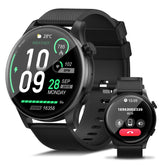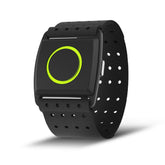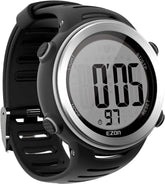Ultimate Running Performance Guide: Heart Rate Training Step & Count Strategies
Elevate your running from good to great with data-driven strategies! This guide combines heart rate monitor insights and step count watch tactics to optimize training for 5Ks, 10Ks, and marathons. Learn zone-based training, smart pacing, and recovery techniques to unlock peak performance.
1. Master Heart Rate Zones for Every Run
A. Calculate Your Heart Rate Zones
- Max Heart Rate (MHR): 220 – age (e.g., 40-year-old = 180 BPM).
-
5 Key Zones:
Zone Intensity Purpose Example Workout 1 Very light Recovery walks 30-min walk at 50–60% MHR 2 Light Aerobic base building 60-min easy run at 60–70% MHR 3 Moderate Lactate threshold training 20-min tempo run at 70–80% MHR 4 Hard Speed endurance 8x400m intervals at 80–90% MHR 5 Very hard Sprint training 20-sec all-out sprints
B. Step Count: The Silent Performance Driver
- Cadence Control: Aim for 170–180 steps/minute to reduce injury risk—use your step count watch to track real-time cadence.
- Daily Activity: Build to 10,000–12,000 steps/day (includes non-running movement) to boost overall fitness.
2. Distance-Specific Training Strategies
A. 5K: Speed and Anaerobic Power
- Primary Zones: Zone 4–5 (80–100% MHR) for speed, Zone 3 for tempo.
-
Workout Example:
- Warm-up: 10-min easy run (Zone 2).
- Main Set: 6x800m at 85% MHR, 90-sec rest (Zone 1).
- Cool-down: 5-min walk + stretches.
- Step Focus: Increase stride turnover during intervals to 185 steps/minute for faster foot strike.
B. 10K: Endurance and Pace Discipline
- Primary Zones: Zone 2–3 (60–80% MHR) for stamina, Zone 4 for surges.
-
Pacing Strategy:
- First 5K: 5–10 sec slower than goal pace (e.g., 4:30/km goal → 4:40/km start).
- Last 5K: Gradually increase to goal pace, using heart rate alerts to avoid redlining.
- Data Tip: Analyze post-run step symmetry (<5% imbalance reduces injury risk).
C. Marathon: Aerobic Efficiency
- Primary Zone: Zone 2 (60–70% MHR) for 80% of training.
-
Long Run Protocol:
- 20–30 km at Zone 2, practicing fueling (gel every 45 min).
- Use heart rate monitor to ensure heart rate stays steady (±5 BPM variation).
- Step Count Role: Track weekly mileage increase (10% rule) to avoid overuse injuries.
3. Pacing Tactics for Race Day
A. Pre-Race Calibration
- Goal Pace Test: Run a 5K at goal race pace 2 weeks pre-race to validate heart rate (e.g., 4:00/km pace should correspond to 75% MHR).
- Course Preview: Use GPS to map elevation—adjust pace for hills (e.g., add 10 sec/km on 5% inclines).
B. Real-Time Adjustments
-
Mid-Race Checks:
- If heart rate exceeds goal zone by 5 BPM, slow pace 5 sec/km and sip electrolytes.
- Use step count to ensure even splits (e.g., 5K splits within 10 sec of each other).
C. Finish Strong
- Final 1K Surge: If heart rate is steady, increase effort to Zone 4—your step count should rise by 5–10 steps/minute.
4. Recovery: The Key to Consistent Gains
A. Heart Rate-Driven Recovery
- Resting Heart Rate (RHR): A 5 BPM increase means take a rest day—prioritize yoga or walking.
- HRV Monitoring: High HRV (60+) signals readiness for intensity; low HRV (<40) calls for gentle movement.
B. Sleep and Nutrition
- Sleep Staging: Aim for 15–20% deep sleep for muscle repair—use your watch’s sleep data to adjust bedtime.
- Post-Run Fuel: 1.5g carbs/kg + 0.4g protein/kg within 60 min (e.g., banana + chicken wrap).
C. Active Recovery Days
- Step Goal: 5,000–7,000 steps on rest days—use a step count watch to avoid complete inactivity.
5. Gear Up for Performance
A. Running Watch Features to Prioritize
| Feature | Benefit | EZON Recommendation |
|---|---|---|
| Multi-Band GPS | Accurate pacing in urban areas | EZON GPS Series |
| Heart Rate Variability (HRV) | Recovery insights | EZON Heart Rate Series |
| Race Pacing Alerts | Real-time goal pace guidance | EZON Pro Running Watch |
B. Essential Accessories
- Lightweight Shoes: Replace every 300–500 miles—use step count to track wear.
- Hydration Pack: Carry electrolytes for runs >90 min, synced with heart rate sweat loss data.
6. Common Mistakes to Avoid
-
Overtraining in Higher Zones:
- Solution: Keep 80% of runs in Zone 1–2—use heart rate data to avoid burnout.
-
Ignoring Step Count Consistency:
- Solution: Build a “step streak” (7 days of 10,000+ steps) for foundational fitness.
-
Neglecting Post-Run Analysis:
- Solution: Review heart rate recovery time (should drop 20 BPM/min) to gauge effort effectiveness.
7. Sample Weekly Training Schedule (10K Focus)
| Day | Activity | Heart Rate Zone | Step Count Focus |
|---|---|---|---|
| Monday | Easy Run (40 mins) | Zone 2 | 8,000 steps |
| Tuesday | Tempo Run (2x15 mins) | Zone 3 | 175 steps/min cadence |
| Wednesday | Rest or Yoga | Zone 1 | 5,000 steps |
| Thursday | Interval Training (8x400m) | Zone 4 | 180 steps/min cadence |
| Friday | Easy Run (30 mins) + Strides | Zone 2 | 6,000 steps |
| Saturday | Long Run (60 mins) | Zone 2 | 12,000 steps |
| Sunday | Recovery Walk (45 mins) | Zone 1 | 7,000 steps |
8. FAQs: Your Performance Questions Answered
Q: How do I prevent hitting the wall in marathons?
- Solution: Practice fueling every 45 mins in training and maintain Zone 2 heart rate for the first 30K.
Q: Can step count help with weight loss while running?
- Yes! Track daily steps to ensure a calorie deficit (10,000 steps ≈ 500 calories burned).
Q: What’s the best heart rate monitor for trail runners?
- Choose a wrist-based monitor with rugged design (e.g., EZON GPS Series) for durability and GPS accuracy on uneven terrain.
Run with Data, Run with Purpose
With heart rate monitor and step count watch insights, every run becomes a strategic step toward excellence. Use zones to optimize effort, steps to build consistency, and recovery to stay injury-free. Whether you’re chasing a 5K PR or marathon glory, let data be your coach and motivation.
Gear up, train smart, and trust the process—your best run is closer than you think. The road awaits—run it with precision, passion, and the power of data.
EZON Watch: Professional sports technology brand
https://ezonwatch.com
https://ezonwatch.com









